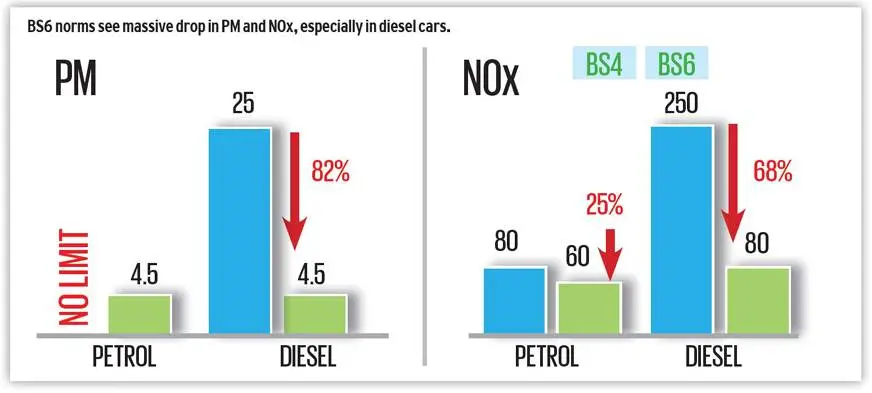The BS6 norms, also known as Bharat Stage 6, are a set of emission standards implemented by the Government of India to control air pollution caused by vehicles. Introduced on April 1, 2020, BS6 marks a significant shift in emission regulations, replacing the previous BS4 norms and aligning with international standards like Euro 6. This change has important implications for car owners, potential buyers, and the automotive industry as a whole.
In this article, we will explore what BS6 norms are, their key features, and how they affect consumers and the automotive market in India.
What are BS6 norms?
BS6 is the sixth phase of the Bharat Stage standards, which regulate emissions of pollutants such as nitrogen oxides (NOx), unburned hydrocarbons (HC), carbon monoxide (CO), and particulate matter (PM). The primary goal of these norms is to reduce air pollution and improve environmental quality in the country.
Compared to BS4, BS6 mandates a drastic reduction in vehicular pollution levels:
- Nitrogen Oxides (NOx): 70% reduction in diesel vehicles and 25% in petrol vehicles.
- Particulate Matter (PM): Up to 80% reduction in diesel vehicles.
- On-Board Diagnostics (OBD) Systems: Vehicles must be equipped with systems that continuously monitor emissions and alert drivers about issues in real-time.

How do BS6 norms affect car buyers?
The transition to BS6 has had a considerable impact on consumers in terms of costs, available options, and long-term considerations. Below is a breakdown of how these norms affect car buyers:
1. Increased vehicle prices
BS6-compliant cars are generally more expensive than BS4 models due to the advanced technologies required to meet emission standards. For example:
- Diesel engines require additional systems like Selective Catalytic Reduction (SCR) and AdBlue.
- Petrol engines have also been redesigned to include more efficient injection systems.
This means buyers need to be prepared for a higher initial cost when purchasing new vehicles.
2. Limited availability of diesel vehicles
Many manufacturers have decided to reduce or discontinue their diesel models due to the significant increase in production costs to comply with BS6. As a result, buyers interested in diesel cars have fewer options to choose from.
3. Improved fuel efficiency and performance
Despite the higher initial cost, BS6 vehicles often offer better fuel efficiency and cleaner performance. This translates to lower operational costs in the long run and a reduced environmental impact.
4. Importance of BS6 fuel
For BS6 vehicles, it is crucial to use BS6 fuel, which has a lower sulfur content (10 ppm compared to 50 ppm in BS4 fuel). Using BS4 fuel in BS6 engines can damage the engine and increase emissions, making the availability of suitable fuel a key factor for buyers.
How do BS6 norms affect the automotive market?
The automotive industry has undergone significant changes due to the implementation of BS6 norms. Some of the major impacts include:
1. Technological innovation
Manufacturers have invested heavily in research and development to adapt their vehicles to the new standards. This has led to the introduction of new technologies in the market, such as:
- Diesel Particulate Filters (DPF).
- Advanced emission control systems.
2. Increased production costs
The transition to BS6 has raised production costs, resulting in higher prices for consumers. Some brands have chosen to discontinue less profitable models to focus on vehicles that can absorb the additional costs.
3. Boost to electric vehicles
BS6 norms have also spurred interest in electric vehicles (EVs) and hybrids, which offer a cleaner alternative and comply with the standards without requiring costly modifications to internal combustion engines.
4. Modernization of vehicle fleet
The norms have accelerated the transition from older vehicles to newer, less polluting ones, promoting a more modern and environmentally friendly vehicle fleet.
Benefits of BS6 for the environment and health
One of the main objectives of BS6 is to mitigate environmental impact and improve public health. Key benefits include:
- Reduction in Air Pollution: BS6 vehicles emit fewer toxic gases, contributing to better air quality in densely populated cities.
- Lower Risk of Respiratory Diseases: By reducing NOx and PM emissions, the norms help decrease health issues related to pollution, such as asthma and other respiratory conditions.
- Compliance with International Agreements: BS6 enables India to meet global commitments on climate change and sustainability.
Recommendations for Buyers
If you are considering buying a car in the BS6 market, keep these recommendations in mind:
- Purchase Recent Models: Ensure the vehicle is fully compliant with BS6 norms.
- Use Compatible Fuel: Verify that BS6 fuel is available in your area to avoid mechanical issues.
- Consider Electric or Hybrid Vehicles: If you are looking for an even more eco-friendly option, EVs are an excellent alternative.
- Evaluate Long-Term Costs: Although BS6 cars are more expensive initially, they can be more cost-effective in the long run due to improved fuel efficiency.
Conclusion
The BS6 norms represent a significant step toward a cleaner and more sustainable future in India. While they pose challenges such as increased costs and adaptation to new technologies, they also bring substantial benefits for the environment and public health. For car buyers, understanding these implications is key to making informed decisions and maximizing the opportunities offered by this transition.


Deja una respuesta